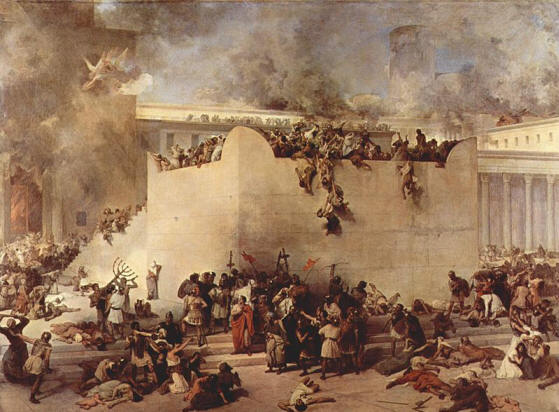For Jews worldwide, the Ninth of Av is a day of deep mourning and reflection. This solemn day brings the community together to remember the tragic events in their shared history, like the destruction of the First and Second Temples and various expulsions. Through religious practices, they honor their ancestors’ suffering and seek repentance from God. However, amidst the sorrow, the Ninth of Av also celebrates moments of joy and resilience in Jewish history. It’s a day filled with profound emotions, bringing together sorrow and hope.
Understanding Mourning in Judaism
Throughout history, the Hebrew calendar has marked numerous tragic events. For the Jewish people, certain days can be considered periods of deep mourning due to the calamities that have befallen them. Scholars, drawing from sacred texts, have identified key days of mourning such as the Seventeenth of Tammuz, Tisha B’Av (the Ninth of Av), and Asara B’Tevet.
A Month of Mourning and Purification
Av is represented by the fifth zodiac sign, the lion, symbolizing Divine energy, love, hope, peace, friendship, and God’s absolute power in ownership and leadership. The name Av is Babylonian, meaning “comforter” (“Menachem Av” in Hebrew). However, despite the destruction of the First and Second Temples in this month, it is also a time for comfort and salvation.
The Talmud mentions the fifteenth day of Av as one of the happiest days for Jews, marking the union of young people from the tribe of Benjamin with others, preventing their extinction. The prophet Jeremiah also offers promises of hope and comfort in his writings.
Practices and Traditions of Tisha B’Av
General practices
As Tisha B’Av approaches, Jews traditionally refrain from celebrations. Some avoid buying homes, new furniture, and clothes, cutting hair, bathing with hot water, and listening to music. On the Ninth of Av itself, specific religious ceremonies and fasting (ta’anit) are observed as a religious duty. From the beginning of Av (Rosh Chodesh) until after Tisha B’Av, meat and wine are avoided, except on Shabbat or if medically necessary.
Symbolism of fasting
The custom of abstaining from meat and wine during this period comes from ancient practices at the Beit HaMikdash (Holy Temple), where animals were sacrificed and wine was offered. Following the Temple’s destruction, these offerings ceased. Over 2,400 years later, Jews continue this practice to remember that time until the Temple is rebuilt.
Purpose of these practices
The Mishnah, in Tractate Ta’anit, Chapter Four, states that the primary goal of this mourning, fasting, and religious observance is to reflect on the root causes of these tragedies, amend behaviors, and draw closer to God. Jeremiah’s writings describe the resilience of Jerusalem’s people during the Temple’s construction, its destruction, and the Jewish condition afterward, captured in his Book of Lamentations (Megillat Eicha), composed of five elegies, each with 22 verses (Parashah), totaling 132 verses.
Themes of the lamentations
Most of the verses of Megillat Eicha deal with Jeremiah’s warnings and prophecies, and the final section discusses comforting and promising prophecies.
- First Lament: Describes the situation of Jerusalem and its citizens after the destruction.
- Second Lament: Discusses the destruction of the House of the Lord.
- Third Lament: Details the calamities, provides reasons for them, and ultimately presents repentance and returning to the Lord as the solution.
- Fourth Lament: Focuses on the conditions of the people due to famine and hunger after the destruction of the First Temple.
- Fifth Lament: Describes the situation of the Jews who remained in Jerusalem and those who were taken into captivity, concluding with the repentance and supplication of the Jews to return to the Lord.

Other Calamities Commemorated on Tisha B’Av
In addition to the events mentioned in the Book of Lamentations, Tisha B’Av commemorates several other tragic events:
Failure regarding the Promised Land
One of the ominous events that occurred in the month of Av happened when the people of B’nei Israel reached the gates of the Promised Land. Moses sent a group of twelve men, one from each tribe, to scout and gather information about the region. Upon their return on the night of the ninth of Av, two men had a positive view of the land of Israel and described it as a land flowing with milk and honey. They were Joshua son of Nun and Caleb son of Jephunneh. The other ten scouts, however, began to criticize and speak ill of the land. This caused fear and panic among a great portion of the people, leading many to weep and wail without reason and decide to return to Egypt. This act aroused God’s anger, and He decided to punish the people.
God said, “Since you wept without reason, I will give you a reason to mourn on this very night.” It was decreed that all those aged twenty and above would remain in the wilderness and not enter the Promised Land. In other words, they were forced to stay in the wilderness for forty years until they perished by the age of sixty. From that time on, this day (the ninth of Av) has been considered a day of mourning and sorrow.
(Based on the Book of Numbers, Parashat Shlach Lecha, Chapter Thirteen)
Aaron’s death
In the fortieth year after the exodus of the people of B’nei Israel from Egypt, on the first day of the fifth month (Av), Aaron, following God’s command, ascended Mount Hor and passed away there.
(Numbers 33)
Destruction of the Temple
One of the most significant and bitter tragedies that has always overshadowed other events is the destruction of the First Temple by the Babylonians during the time of Zedekiah in the year 3338 in the Hebrew calendar (422 BC). Additionally, the Second Temple was destroyed by Titus in the year 3828 in the Hebrew calendar (70 AC), during the time of Rabbi Yochanan ben Zakkai. Both events occurred on the ninth of Av, 490 years apart.
Impact of these events
On Tisha B’Av, Jews refrain from joy, fast for 24 hours, and engage in religious ceremonies, reading Jeremiah’s lamentations to remember the tragedies. Unlike other days, Tefillin is worn in the afternoon prayer rather than the morning, concluding the fast with hope for the Temple’s reconstruction and the coming of the Messiah.
Nebuzaradan’s attack on Jerusalem
Nebuzaradan, a Babylonian general, attacked Jerusalem on the 7th of Av. Along with the Chaldean soldiers at his disposal, he destroyed the walls of the city, and then proceeded to burn the Temple, the royal palace, and all major buildings (Kings 25:8-10).
The fall of Betar
Betar was a central hub for religious scholars and thinkers. Fifty-two years after the destruction of the Second Temple, the city faced a massive assault by Roman armies. The attack and massacre were so devastating that historians of that time described the tragedy by saying that the legs of the enemy’s horses were submerged up to their knees in the blood of the slain residents. The city of Betar fell on the ninth of Av and was reduced to a heap of rubble.
Expulsion from Spain
In 1492, over 300,000 Jews were expelled from Spain by order of King Ferdinand II, forced to leave behind all possessions and flee barefoot, leading to many deaths during the journey. According to the decree of expulsion, Jews were ordered to either convert to Catholicism or leave Spain. This forced migration led to the deaths of many children and elderly individuals during the journey. Those who survived vowed never to return to Spain.

Enemy soldiers carrying the spoils taken from the Holy Jewish Temple. The seven-branched Menorah from the Jerusalem Temple was taken to Rome by Titus, the ruthless Roman emperor, after destroying the Second Jewish Temple. This engraving was made on the columns of the Roman gates to commemorate their victory.
Sources
Mythological Beliefs: Yosef Setareshenas


 فارسی
فارسی